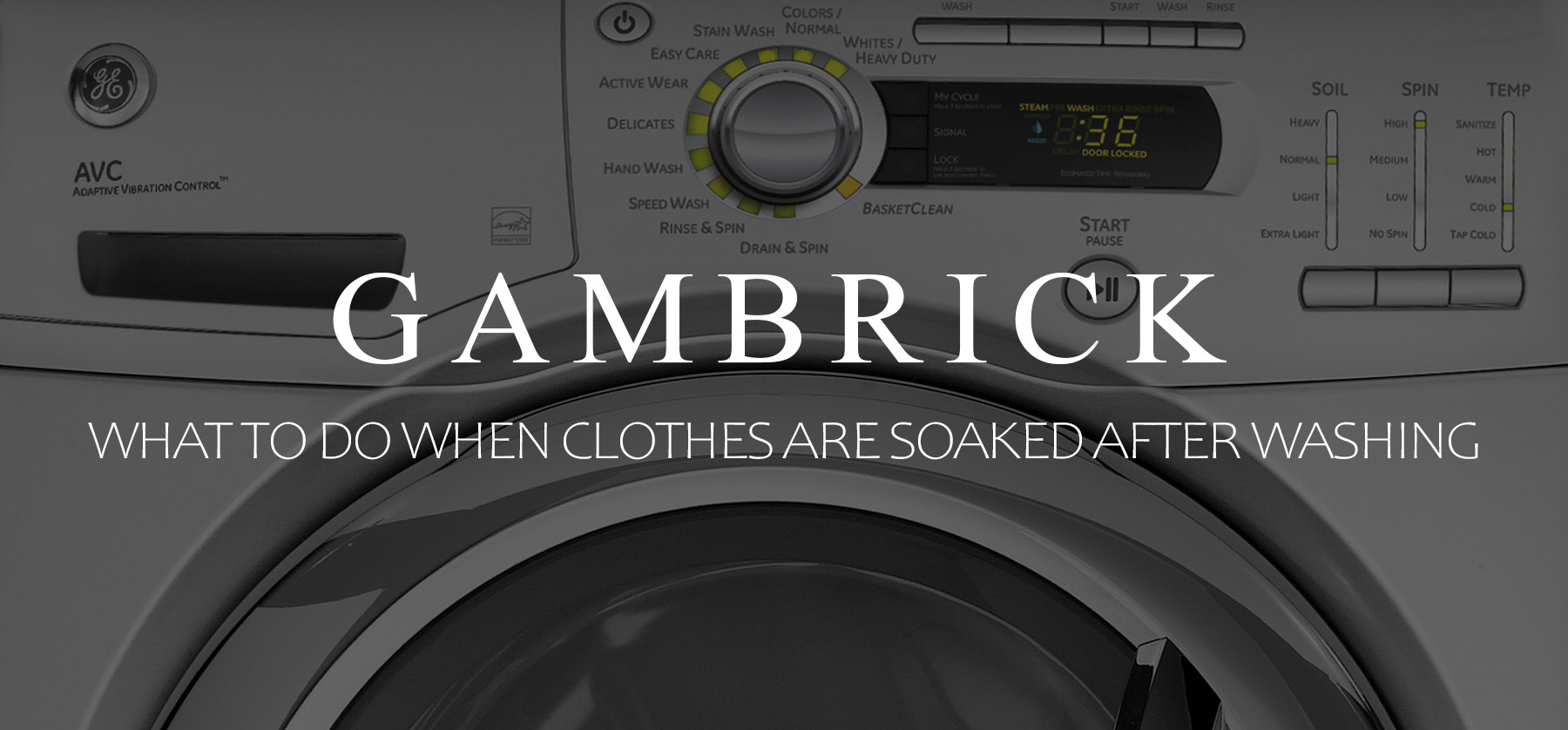What To Do When Clothes Are Soaked After Washing
Clothes should be slightly damp after a wash cycle, not soaking wet. This makes drying them much easier because most of the water has been drained by your washer’s spin cycle. A few problems can occur in your washing machine that can cause your clothes to be soaked after a spin cycle was supposed to dry them. Your washer may still spin and work typically, yet your clothing is still wet after a wash, or your washing machine could stop spinning altogether. The most likely cause is a drain hose problem. Here’s how to troubleshoot, diagnose, and fix the problem.
- Turn the washer OFF and pull out the main plug.
- Inspect the hose to make sure it’s not kinked. If it is, straighten the hose out.
- Loosen the hose clip on the siphon and remove the drainage hose and any residual water.
- Clean the drainage hose and siphon spigot.
- Hold the drainage hose in a bucket and select the DRAIN setting.
- Connect the drainage hose to the siphon and check for leaks.
- Run a test wash and see if the issue has been fixed.
If your clothes are still wet after a spin cycle because of the drain hose, it’ll be fixed once you clean and straighten it out.
Some other common reasons why your clothes may not be drying after a wash are the washer pump, how you’re loading the machine, using too much detergent, the extension cord, a setting, or a part failure.
If the issue is overloading, remove and/or redistribute some items and run another rinse and spin cycle. This will create a more balanced load and enable proper drainage. Avoid overloading by filling the washer ¾ of the way full with each wash load.
Washer Pump Blocked or Needs to be Cleaned
If your washer’s filter or pump is partially or fully blocked, it can affect your appliance’s ability to drain water. This can cause your clothes to be wet after the spin cycle is complete. To fix the issue, you must inspect the pump to make sure it’s working correctly. But be careful when working on your washer’s pump. Leaking water could be very hot, with a risk of scalding.
Here’s how to troubleshoot and diagnose the problem, clean the pump, and resolve the issue:
- Turn your washer OFF and pull out the main plug.
- Open and remove the service flap.
- Slowly remove the pump cover and drain any water through the drainage hose.
- Clean the interior, pump cover thread, and pump housing.
- Make sure the impeller wheel of the pump can turn.
- Re-insert the pump cover and screw it on firmly.
Once you’re all done, check for leaks by pouring 1 quart (1 liter) of water into the detergent dispenser and starting a DRAIN program. If you don’t find any leaks, run a test wash.
If your washer’s pump caused the problem, the clothes should be damp after the spin cycle is complete.
Your Laundry Load Could be Imbalanced
Another common reason your clothes may be wet after a wash cycle is an unbalanced load of laundry. For example, if there are lots of clothes on one side of the drum, it can prevent the washer from draining excess water as it spins. The clothes pile traps water inside, which leaves your clothes soaking wet after the spin cycle is complete.
If the imbalance is too large, the spin cycle may reduce speed to protect your appliance or not run at all. In addition, your washer could try to improve the laundry distribution by spinning. This extends the wash cycle running time.
Luckily, this is easily fixed by evenly distributing your laundry inside the drum and not overloading the washer. Here are a few tips you can follow:
- Wash large and small items together to reduce the imbalance.
- Close zippers and buttons on pillows and duvet covers.
- Don’t overload the washer drum.
- If you wash a large item, evenly place it inside the drum.
If your clothes are wet after a wash and bunched up on one side of the washer, you probably overloaded the appliance, or the drum is unbalanced. Remove some clothes or redistribute clothes inside the drum and run another spin cycle to remove excess water.
If you’ve severely overloaded the machine, you may need to split the load into two wash cycles to remove all the water.
Too Much Detergent
Using too much detergent is another common reason your clothes can be wet after a wash cycle. If your washer is filled with suds after the wash cycle is complete, it could be why your clothes are still wet. This is because soap suds can stay on your clothes even when excess water is drained.
To fix the problem, use less detergent or switch to low-suds or higher-quality detergent. Make sure you’re measuring carefully and read the instructions on the label and your washer.
5 Reasons Why Your Washer Leaves Clothing Wet
When your washer leaves clothes wet, it can create a mess and put extra strain on your dryer, potentially shortening its lifespan. However, you can easily troubleshoot and resolve this issue with these five simple tips, saving you time and energy.
1. Check the Power Cord
Make sure that your washer is using a standard power cord and not an extension cord. Extension cords may not provide enough electricity for the washer to function properly, leading to decreased spin speed and wet clothes. Moreover, using an extension cord can cause overheating and shut down mid-cycle, leaving your laundry soaking wet.
This is a straightforward fix. Make sure to plug your washer directly into the outlet or use an extension cord rated for the power requirements of the washer.
On average, a washing machine uses 400 to 1,400 watts of electricity, depending on the model. Most washing machines use between 5 and 15 amps and connect to a 120-volt outlet.
2. Avoid Overloading
Loading too many items into the washer can lead to an imbalance, reducing the spin speed and leaving your clothes excessively wet after the cycle completes. To fix this, remove some items, redistribute the load, and run another rinse and spin cycle for a better balance. Remember, it’s best to fill the washer only ¾ full to prevent overloading. Refer to your washer’s user manual to know its specific capacity.
When loading a washer, make sure not to overload it and distribute the clothing evenly. Wash large and small items together to reduce the imbalance. Close zippers and buttons on pillows and duvet covers so that clothing doesn’t get stuck together.
3. Check the Cycle Settings
Make sure you’ve selected the appropriate cycle setting for your wash load. Delicate or hand wash settings may have a slower or no spin cycle to protect your clothes, leaving them wet for the dryer. Adjust the spin speed if needed to make sure your clothes come out properly spun.
4. Check for Part Failures
A washer leaving clothes too wet might be experiencing part failures that affect the spin cycle. Check these components:
- Lid Switch Assembly (Top Load Washers): This assembly stops the washer from spinning when the lid is open. If it malfunctions, even if the lid is closed, the washer won’t spin. Test the switch with a multimeter and replace it if needed.
- Door Latch (Front Load Washers): Similar to the lid switch, the door latch signals the washer to start a cycle. If it fails, the washer won’t spin. Check for damage or failures with a multimeter and replace it if necessary.
- Drive Belt: The drive belt supports the drum’s weight as it spins. If it frays or breaks, the washer won’t spin properly. In this case, you’ll need to replace the damaged drive belt.
5. Resolve Drainage Issues
Poor drainage can also leave your clothes wet. Here’s what to do:
- Drain Hose Kink: Inspect the drain hose for kinks or twists and straighten them out to ensure proper water flow.
- Drain Filter Clog (Front Load Washers): Open the small access panel at the bottom of the washer, remove the drain filter, and clean any debris that may have accumulated.
- Drain Pump Malfunction: If there are no visible clogs, check the drain pump behind the back panel. Test it with a multimeter for continuity. If the readings are off, the pump is faulty and requires replacement.
Is it Okay to put Soaking Wet Clothes in the Dryer?
No, putting soaking wet clothes in the dryer is not okay. When clothes are actively dripping water, it’s risky to try drying them in the dryer. The excess water can fly around the dryer’s drum when it spins, potentially causing damage. Furthermore, some water might seep into the internal components of the dryer, leading to immediate breakdowns.
Dryers are designed to dry slightly damp clothes, not soaking wet.
Instead, before putting clothes in the dryer, they’re adequately wrung out or run a proper spin cycle in the washer to remove excess water. This will prevent potential damage to the dryer and help your clothes dry more efficiently and safely.
Always check the manufacturer’s instructions for the recommended drying process and follow their guidelines to keep your clothes and the dryer in good condition.
What Does it Mean When your Clothes are Soaked After Washing?
If your clothes are soaked after washing, there are a few potential issues you should look for. The washer could have a problem, such as a clogged or crimped drain hose, an issue with the washer’s pump, or a damaged part. The wet clothing could also be caused by human error, such as using too much or the wrong detergent, overloading or unevenly loading the appliance, or using an improper extension cord.
After you wash your clothes in a washing machine, the spin cycle should drain excess water, leaving the clothes damp but not soaking wet. If your clothes are wet after a wash, troubleshoot each potential issue one at a time until you find the problem. Generally issues like this are very easy to find and fix.
Summary: What To Do When Clothes Are Soaked After Washing
Clothes should be slightly damp after washing, not soaked. This makes drying them much easier because most of the water has been drained by your washer’s spin cycle. A few problems can occur in your washing machine that can cause your clothes to be soaking wet after a spin cycle was supposed to dry them. Your washer may still spin and work typically, yet your clothing is still wet after a wash, or your washing machine could stop spinning altogether. The most likely cause is a drain hose problem. Here’s how to troubleshoot, diagnose, and fix the problem.
- Turn the washer OFF and pull out the main plug.
- Inspect the hose to make sure it isn’t kinked.
- Loosen the hose clip on the siphon and remove the drainage hose and any residual water.
- Clean the drainage hose and siphon spigot.
- Hold the drainage hose in a bucket and select the DRAIN setting.
- Connect the drainage hose to the siphon and check for leaks.
- Run a test wash and see if the issue has been fixed.
If the reason why your clothes are wet after a wash was the drain hose, it should now be fixed.
Some other common reasons why your clothes may not be drying after a wash are the washer pump, how you’re loading the machine, using too much detergent, the extension cord, a setting, or a part failure.
If the issue is overloading, remove and/or redistribute some items and run another rinse and spin cycle. This will create a more balanced load and enable proper drainage. Avoid overloading by filling the washer ¾ of the way full with each wash load.
If you have any questions or comments email any time.





















